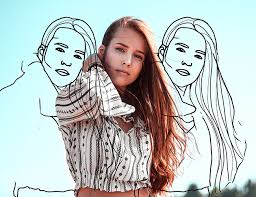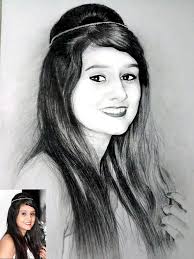Transforming Art: How Picture to Sketch AI Encourages Creativity
You click an awesome snap of your favorite café in rain; rain drops on the window-very poetic. You feel like something artistic should be added to that pic. Here, picture to sketch ai comes into play, helping you get your photos turned into sketches and adding a pinch of creativity to them.

Such magic is the result of complex data processing in which algorithms analyze features of an image. It creates a capturing-in-effect pencil-like rendering by amplifying the details, exaggerating the lines, and reducing noise. This is like changing the brush to the chisel to carve the art from stone. Each line reflects your creative pulse, drawn from your original image.
AI make art and creation a game-changing thing with picture to sketch capabilities. It converts the photos into a pencil sketch-a reinvented digital file. Magic happens when a world of color pops into an elegant monochrome. It gives a tint of nostalgia, just like shuffling pages from some really old sketchbook. Graphics designers gain hugely, too. A humble drawing becomes a work of art-as much as drawings created in graphite and charcoal do-without smocks full of soot.
Now, versatility: It’s the device that works wherever you work-whether in Photoshop or in your digital notebook.
In an instant, your picture is transformed into a drawing, and instead of toiling, you are having fun over a cup of coffee. This very tool lays some very sketchy illustrations over digital canvases or even marketing material with ease. One could never imagine that a couple of lines worked the magic.
That again is a factor of attraction between illustrators and comic artists alike. Sam is a budding comic artist. He cannot avoid doing mundane backgrounds in his story. But through this AI, with only the same drawing, exciting things can be done with just pictures. His visuals have taken an exemplary flare, and even with mundane days they are marketable. That makes this AI a blessing for those who are racked by deadlines every now and then.
Sharing is caring; in this digital era, when eyes widen with wonder looking at graphics-why not make a picture a bit more personal? A photo-turned-sketch shared via social media startles followers. A hand-sketched happy birthday card to Grandma over her garden made with AI would be the warmest hug in a postcard.

The algorithms can be quirky; one joked his AI sketch seemed to be out of an ’80s noir film. He kept it because it was so funny. There is almost a fun kind of unpredictable thrill to it, the same way as when waiting for film photos to develop and not being entirely sure what got captured. Actually, AI innovations in the field of drawing leave no man behind, be it a hobbyist or professional, since all of these remove barriers to entry. It is like giving a child a blank canvas on which he projects his dreams; you might discover hidden artistic talent. Not about replacing the hard work of an artist, but the possibility of working with an at-hand AI, so does that continue to make anyone hesitant? Welcome your magician AI, breathe life into your projects, and make each image look extra special.
Oops, Did I Draw That? Photo Art Mistakes to Avoid
It releases your inner Van Gogh and summons him to meet your favorite snapshots-what enviable wedlock between technology and creativity. That’s what picture-to-sketch AI does. But just like baking bread without a recipe, a couple of things can terribly go wrong in this artistic journey. Let’s discuss a few common pitfalls that may arise in the due course of this artistic journey.
Then comes over-filtering-the stuff that’s akin to wearing too much makeup-you can hardly recognize yourself. You put filters on for an artistic effect and then get a juvenile scribble. It would be best to avoid these, allowing the photo textures to speak for themselves and guiding AI with the delicacy of touch of a good sailor.
Start with low-resolution images. You try to paint the masterpiece with a toothbrush-sized brush, which, again, makes no difference. You end with a drawing that is far more pixelated than those retro games. For the smoothness in AI’s processing, it would want to be on a high-resolution image to be any good.
Watch out for lack of contrast. Saltless bread? Not all that tasty, either. Mushy grays and screaming whites are the enemies of the flat sketch. Go ahead and play with light and dark before you flatten, like you were fiddling with the stage lights before the show starts.
Ever heard of rogue composition? Family photos as sketches should be on purpose. Check the composition first; then crop or reposition subjects. Be able to get rid of the photobomb of Aunt Marge and show the playful grin of your dog instead. Two birds, one stone!
Ah, here’s one that gives me a giggle: making light of the limitation of AI’s output. It confuses images to dare the machine-obviously a recipe for disaster, not art. It is like expecting a microwave to make great dishes. Know the limits of what AI can handle and stay within them.

Overdependence on AI suppresses creativity much the same as one relies on GPS at every turn of a scenic drive. Let AI be your guide, but add some flair. Be the copilot, not the backseat driver.
But it’s just so tempting for shortcuts, and they always cut corners where it comes to quality. Take the shortcuts to hastily finish the quickest way turns into sloppily doing the result of your work-a poorly wrapped gift. Allow the time to let your creation shine.
And finally, there is the pain of neglective saving: building an elaborate sand castle and then having the tide take it away because one forgot to take a picture. Save often, save in multiple formats, save in multiple places. Never let it slip into the void.
Handle it with care, and it turns your photos into museum-quality sketches, at least in the living room. It’s tough, but with these tips, one would be able to keep the no-nos at bay to bring on more masterpieces. Now, show us those sketches!
